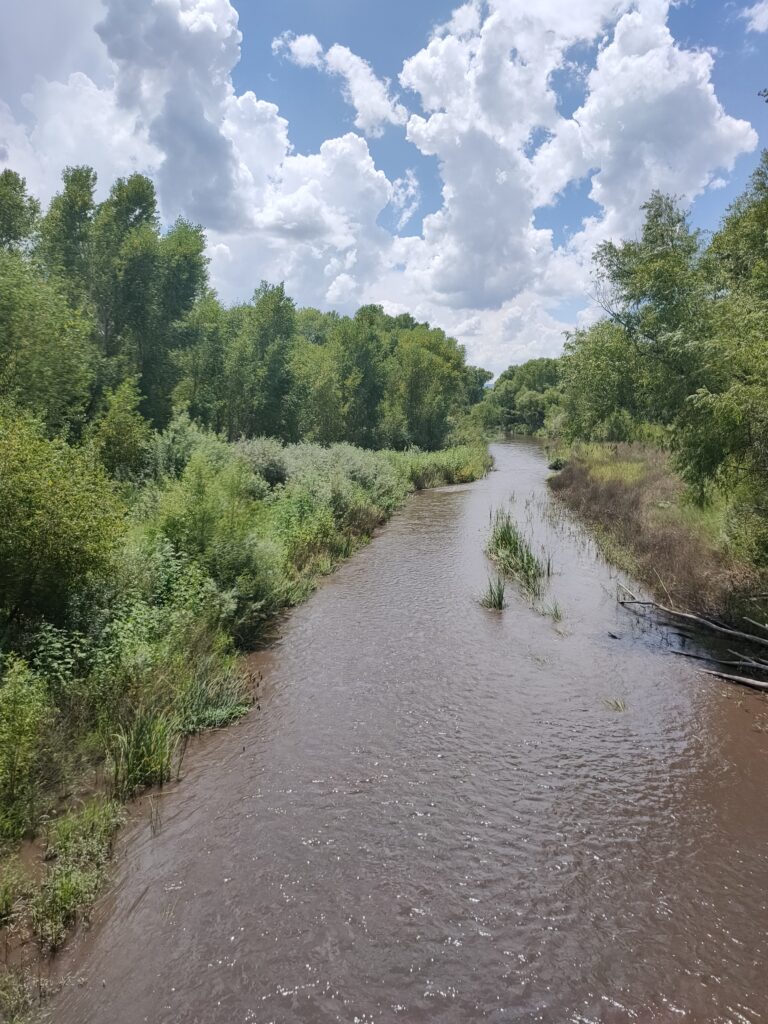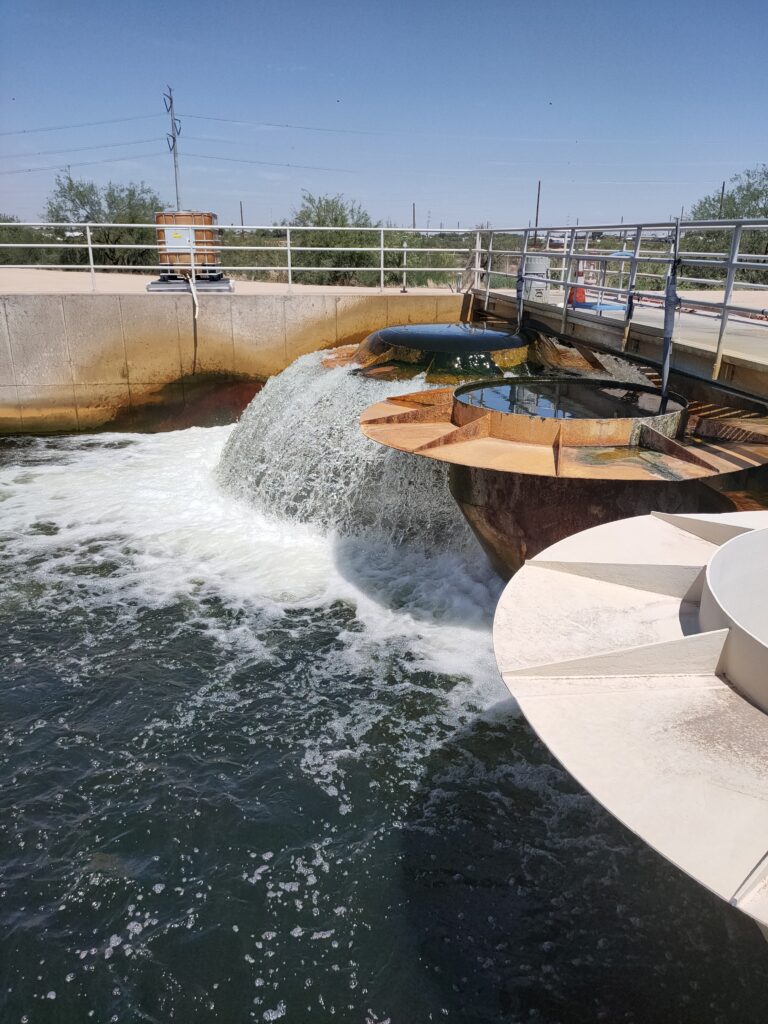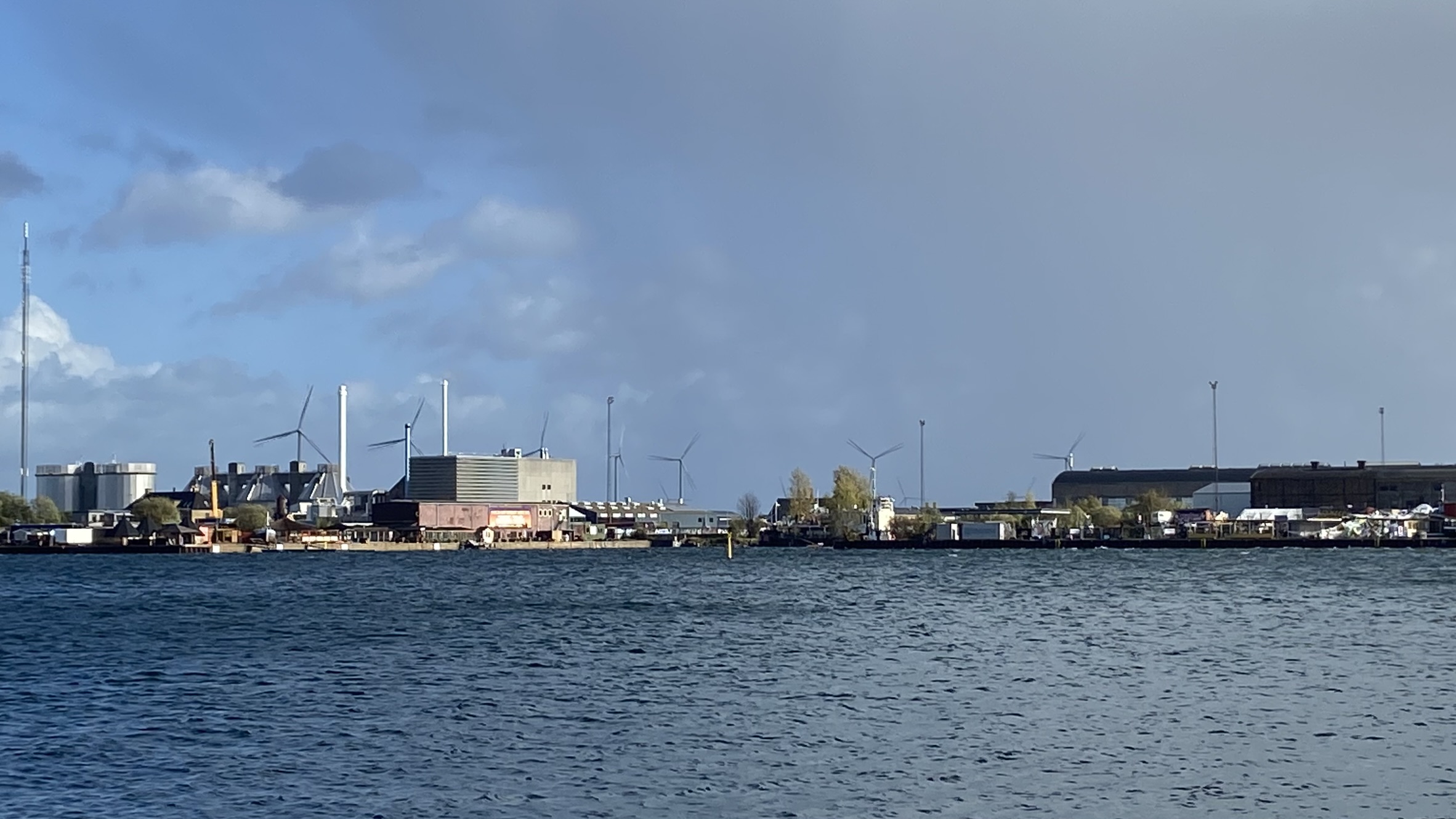Great rivers, it is said, shape the environments through which they flow. Their waters give life and shape the course of human events along their banks. The Amazon, Congo, Nile, Mississippi – the very names of the great rivers evoke not only vast space, but entire cultures and ways of being that have been formed by floodplains and river flows. The adage can now be flipped; today, humans shape rivers.
Few places exhibit this more than the American West, where all rivers of significance have been shaped by human hands and machinery. Large-scale damming, canals and aquifers along the region’s waterways sustain millions of people, and have inspired staggering bodies of literature and scholarship. In the arid west, the scarcity of water has elevated its management, and those responsible for it, to near-mythic dimensions of power.
One of the Southwest’s lesser known, but equally vital, waterways is the Gila, a river that flows west from the Black Range in New Mexico to Yuma, Arizona. To speak of a single river when discussing the Gila may be less useful than perceiving the Gila as a connected series of different waterways, changing their appearance and function again and again, altered by human intercession or lack of it. Along its 1,000-kilometer run, the Gila shifts from a historicized wilderness river to a tightly managed agricultural canal. In some places it rushes 2 meters deep, only to disappear again completely into the rocky terrain a few miles further east. Mining and energy interests have harnessed its hydroelectric power, and environmental advocates use its symbolic power to fight to preserve the flora and fauna that it sustains.
Most vitally, the banks of the Gila and its floodplains are home to millions of people, many of whom trace their histories back thousands of years before the first contacts with European colonial powers. In 2021 at the peak of another historic wildfire season, and following the first ever water shortage to be declared on the vital Colorado River, the pressures on the fragile ecosystems of the American West are at an all-time high. Climate change is accelerating environmental degradation, and the economic and social costs are being distributed unequally to rural and indigenous communities.

The headwaters: preservation & exoticization
“People still collect artifacts,” says Marilyn Markel on a sunny morning. “Usually they don’t dig anymore.” Markel is the archeologist of the Mimbres Culture Heritage Site, located in a remote corner of southwest New Mexico. Markel is speaking on the wide porch of the old farm house that serves as the museum and headquarters of the small organization – a unique partnership between a private conservation organization and public stakeholders. Like everyone at the Heritage Site, Markel is a volunteer. The artifacts she refers to were produced by the Mimbres culture, a prehistoric group that populated the Mimbres, Gila and Rio Grande floodplains, and dispersed before Europeans colonized the area. The Mimbres are best known today for their beautifully painted pottery, much of which was created for the use in burial sites. The volunteers at the site in New Mexico assume that the vast majority of Mimbres artifacts have either been looted or remain with their descendants, and that many of the most significant pieces produced in the area will likely never be seen by the public.
Kathy Hill is another volunteer who leads tours around the small museum. The Mimbres Culture Heritage Site occupies part of a former ranching property, which was built on the remains of a Mimbres village. Hill shows a small reconstruction of the original site, a tidy collection of boxy, single-story homes and small agricultural plots. The Mimbres pottery, polished bowls painted with abstracted animals and other forms, occupy particularly prominent positions in large, well-lit cabinets along the walls. Hill explains that nearly every piece of pottery on display in the museum is a reconstruction. The site is too remote, and security would be too expensive to adequately secure originals.
From the east, north, and west, the Mimbres museum is bracketed by the Gila National Forest, a vast expanse of federally administered public lands. Aside from a few ranch homes and vacation cabins nestled close to the few rural highways and service roads that bisect it, the forest is devoid of significant human structures. The forest contains the Gila Wilderness, the first area to be designated as such in the United States. Passed in 1964, the Wilderness Act provides for “untamed” areas, as a specific response to “increasing population, accompanied by expanding settlement and growing mechanization.” The proto-conservationist Aldo Leopold, a former Forest Service supervisor, is credited with the creation of not only the Gila Wilderness, but also the system that now accounts for over 109 million acres across the United States. Here, the needs of plant and animal life take precedence over resource exploitation and other profit motives.
During a visit to the Wilderness in August 2021, the region had been experiencing exceedingly rare monsoon rain, and was blooming with new vegetation. An overgrown hiking trail follows and criss-crosses the Gila River, and leads further into the protected area. The river was running shallow and clear, and its densely green banks were playing host to a variety of wildlife. Groups of roaming javelina, bat colonies flying overhead, a loud rattlesnake making its presence known – all seemed intent on underlining the word “untamed” for the first-time visitor.
As beautiful as the vision of an untouched Eden in the American Southwest may be, it is—and has always been—a fantasy. That this utopian myth of the untouched Gila still holds such currency must be chiefly ascribed to the ongoing erasure of its indigenous history. Aldo Leopold is often mentioned in the same breath as John Muir – the founder of the Sierra Club, protector of Yosemite and the Sequoia National Forest, and an avowed racist, both towards indigenous as well as black Americans. It is not useful to simply overlay Leopold’s stance towards the lands’ original inhabitants with those of Muir and call them the same, however. Leopold didn’t trade in the cliches of biological racism like Muir, because he very seldomly mentioned Native Americans at all. When he did, it placed indigenous people not in the realm of humans, but in that of nature. In Leopold’s seminal work, the Sand County Almanac, he traces the imagined life of a single atom in a North American wilderness: “He ended up in the silt of a backwater bayou, where he fed a crayfish, a coon, and then an Indian, who laid him down to his last sleep in a mound on the riverbank.” Other than scattered positive mentions of their land stewardship, there is no mention of an indigenous presence at all.
Resource & Power: the Gila River in Arizona
The Gila’s appearance undergoes a major transformation shortly after crossing Arizona’s eastern edge. After reaching the valley floor, its meandering and intermittent flow traces a looping line across the southern portion of the state. It is diverted into angular canals that tidily trace the highway, and are utilized for usage in the band of agricultural land that runs all the way to western outskirts of Phoenix. Along with a few other rivers and large underground aquifers, the Gila has nourished human life in the Arizona desert for thousands of years. Despite the fact that the Valley of the Sun, or present day Phoenix metro area, has been continuously populated by indigenous peoples, an effort has been made to erase their presence in favor of the myth of a pristine wilderness. Intricate irrigation networks built by the prehistoric Hohokam, and their modern descendants—the Akimel O’odham, Pee-Posh and other tribes of this part of the state—represent not only important infrastructure, but people with agency.
“I would say that a majority of my time is spent on water,” says Jason Hauter about his legal work for the Gila River Indian Community. Hauter is both a tribal member and part of a law firm that serves as its outside counsel, and has been at the frontline of a historic effort to reclaim water access for the community, located adjacent to Phoenix. Over the phone from DC, Hauter outlines the fraught history of water rights since the arrival of white settlers in the late 19th century. While tribal communities initially helped new arrivals survive in a new and difficult environment, they were quickly overwhelmed by diseases, losing control of the Gila River as well as the use of the areas’ other major waterways for drinking water and agriculture. What followed was a period of deadly poverty, juxtaposed with the rapid growth of the area’s white agricultural and mining economy. The confederate war veteran who is credited with the creation of Phoenix based his ideas of irrigation agriculture in the area firmly on the networks that had been previously created by the Hohokam, and then used them to deprive their descendants of access.
In 2004, the Arizona Water Settlement Act significantly changed the course of the Gila River Indian Communities’ ability to access its historic water rights. The court settlements allotted the tribe a large portion of water from the Central Arizona Project (CAP) a complex system of canals that brings the state vitally important water from the Colorado River, as well as other sources. Although implementation wouldn’t start until a few years after passing of the Act, it is premised on a Supreme Court ruling from 1908 that held that Indian reservations established by the US government must be supplied with a perpetual supply of water. As water rights in the American West are at least nominally awarded to those communities with the longest history of settlement, this put the Gila River Indian Community at the front of the line. With the signing of the act by then-President George W. Bush, the Gila River Indian Community suddenly became the Valley of the Sun’s largest owner of water rights, dwarfing even the CAP allotment to the city of Phoenix.
Hauter quotes Stephen Roe Lewis, the current governor of the Gila River Indian Community when he says that the objective of the tribe’s water management was to make sure that “the next generation doesn’t have to endure what the last one did.” The CAP allotment is now the basis upon which the community is building a water supply in perpetuity, as well as once again allowing for traditional and modern agriculture on tribal lands. In addition to providing for the community’s own water supply, the allotment has given the Gila a significant tool for boosting its income via a series of unique exchange and swapping deals with Phoenix and other communities. An additional portion of water has been committed to a recharge program for the Gila River, which has brought the river back to life along a managed site on tribal land.

“The management of water is extremely interrelated with Native American communities,” says Kathryn Sorensen. “And in many ways they are in charge.” Sorensen is the former director of Phoenix Water Services, and now focuses on water management as a part of the Kyl Center for Water Policy at the University of Arizona. Sorensen is candid in describing the process that led to the settlements as “extremely slow and painful,” but remains noticeably proud of the results. Sitting by a small restored hydroelectric facility known as the Arizona Falls, the sound of rushing water in the background, Sorensen describes the unhealthy condition of the Gila River after 100 years of overuse and mismanagement. Sorensen’s own roots reach back to the white Mormon settlers of eastern Arizona, whose descendants are dependent on the same overstretched reservoirs upon which the local Navajo tribes rely.
Considering they nominally once occupied the opposite side of a negotiating table, Jason Hauter and Kathryn Sorensen share a remarkable number of attitudes about the management and preservation of water in the Valley of the Sun. They acknowledge the emotionally and physically taxing nature of the talks that led to the current set of agreements between the city of Phoenix and the Gila River Indian Community. However, both Sorensen and Hauter seemed more interested in emphasizing the success of the system than its traumatic inception. In Hauter’s words at least, the tribe’s primary motivator in working with Phoenix and the other settler-descended communities in the area is mutual concern over the resource. Lastly, they share a particular form of exasperation at having to continually explain to outsiders that the water management system in the Valley of the Sun is not at the brink of a catastrophic collapse in the face of drought. Sorensen explains that Phoenix now uses the same amount of water as in the 1950s – despite having grown by six million people.
The Tres Rios wetlands are a “vital wetland and riparian habitat,” as described by Phoenix Water Services. Multiple large ponds, lushly overgrown with high reeds and grasses are tucked into this agricultural pocket southeast of Phoenix. Even at high noon on a hot summer day, there is a parade of fauna on display here: flocks of mourning doves nesting in the invasive tamarisk, herons stoically patrolling the water’s edges, where the plump outlines of catfish are clearly visible. The amount of open, moving water found at Tres Rios attracts a staggering amount of plant and animal life, rare as it is in this desert region. The site is also almost entirely artificial, and fed by restored city wastewater which is filtered here before being returned to the Salt River. The stark lines of concrete retaining ponds are visible under the schooling fish, the lines of the banks too straight to be natural. Lisa Bird is the Operations and Maintenance Supervisor for Tres Rios, and responsible for maintaining the water flow and plant life. She is fiercely protective of the site, and its opportunity to regenerate. She keeps trespassers out of the sensitive parts of the site and lets the natural environment thrive as best as possible. “The trees grow how they grow,” she says.
The state of the Gila River – or more accurately, its disparate segments, is an indicator for the strained waterways of the American West. The primary water user in the region by a large margin continues to be agriculture, not its fast-growing cities and suburbs. Technological advances are making it possible for more people to live with less water, while an acceleration of climate modeling calls into question whether there will be enough. As the tribal attorney Jason Hauter acknowledges, effective water management is only useful to the point at which a place is still livable. On a day in which the temperature in downtown Phoenix reached 44 degrees Celsius, a tipping point did not feel entirely remote.
The Gila River Indian Community water settlement is a vital and far-reaching piece in putting original owners back into control of their resources, and has generated remarkable results in the short timeframe since its implementation. Overwrought notions of new resource conflicts between tribal communities and Anglos are laid to rest by the interdependent system of exchanges that are now in place in the Valley of the Sun. The intensive regeneration of wastewater and other measures developed in Phoenix may well serve as guideposts for a slew of other cities across the world that are quickly becoming hotter and dryer.
However, many other tribes in Arizona remain disenfranchised of their access to water. Members of the Hopi and Navajo communities live without running water or supplies tainted by pollutants, sometimes in sight of wealthy, non-tribal communities. For many, obtaining water rights are not premised on their history in a given region or on the continent, but by the federal acts that created the reservations. “Prior appropriation,” the doctrine on which water rights in the West are recognized and allotted, has recognized the past and presence of the Gila River Indian Community. Other tribes in Arizona and beyond remain cut off from those same ancestral resources because the federal government does not recognize their history of use. Some tribes with recognized rights have opted to settle out of court, to avoid the kind of long and costly legal proceedings that were necessary to bring water back to the GRIC. Recognition of indigenous life is still awarded by the same government that for so long sought to destroy it.
Additionally, the wholesale reform of agriculture that will be needed to retain the necessary water resources to keep the human population of the West alive will undoubtedly bring painful changes to thousands of communities. There are no plans or resources in place to address the coming disparities between urban and rural life, a gulf that is too large already. While Phoenix carefully regenerates every drop of water it finds, the mining company Freeport McMoRan operates a total of five different open pit copper mines on different sites along the Gila between Arizona and New Mexico. A solution for the people that call the Gila River watershed home will ultimately need to address the entire system, and not just its disjointed segments.
Johannes Streeck is a German freelance journalist who focuses on the United States



